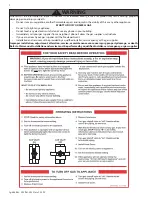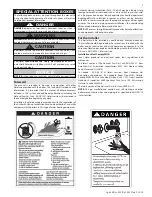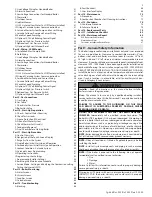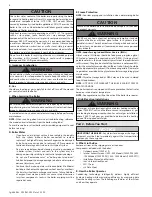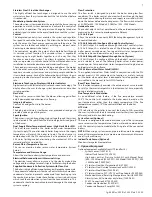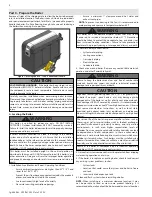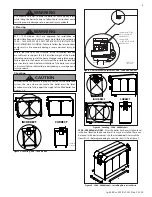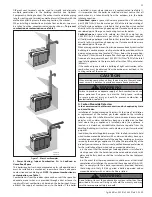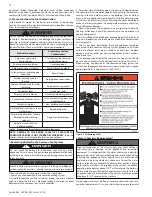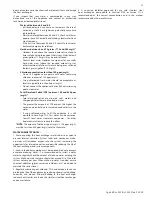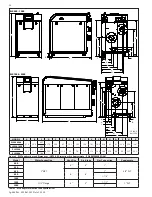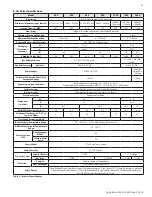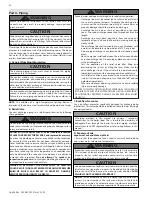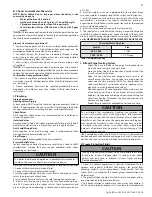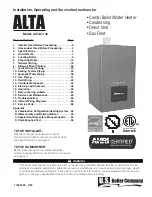
lp-666 Rev. 003 Rel. 001 Date 2.25.20
4
NOTICE
The CSD-1 ASME Code, Section CW-400 requires that hot water
heating and supply boilers have a) a UL 353 temperature control
device, b) at least one (1) temperature-actuated control to shut
off the fuel supply when system water reaches a preset operating
temperature, c) a high temperature limit control that prevents
the water temperature from exceeding the maximum allowable
temperature by causing a safety shutdown and lockout, and d) its
own sensing element and operating switch.
The temperature control system integrated into the 928 control
provided with this heating appliance complies with the requirements
of CSD-1 Section CW-400 as a temperature operation control. The
control monitors the temperature difference between the inlet
and the outlet sensor, which is affected by boiler water flow. If this
temperature difference exceeds 55°F (typically because of low water
flow or very low heat load), the control will reduce the maximum fan
speed. If the temperature difference exceeds 60°F, the control will
effectively sense there is little or no water flow or heat load and shut
the boiler down. The controller will restart automatically once the
temperature difference has dropped below 55°F and the minimum
off time (anti-cycle time) has expired. In addition, if the control senses
that the outlet water temperature has reached 210°F, the boiler is put
into a hard lockout and requires manual reset to restart.
WARNING
!
The hydronic supply and return connections of these products
are for installation in closed loop systems ONLY!
Use of this
product in any manner other than described in this manual may
result in premature product failure, substantial property damage,
severe personal injury, or death. Damage or failure of this product
(or the system in which it is installed) due to unauthorized use
IS
NOT COVERED BY WARRANTY.
IMPORTANT
In accordance with Section 325 (f) (3) of the Energy Policy and
Conservation Act, HTP has provided this boiler with multiple
features designed to save energy by reducing the boiler water
temperature as heating load decreases.
These features include:
•
A modulating combustion system that adjusts firing rate
based on heat demand.
•
Adjustment of boiler set point based on inferred heat load
as determined by an outdoor sensor. The outdoor sensor
is supplied by HTP with this boiler.
•
This boiler does not include a standing pilot.
•
This boiler is designed and shipped to assure the highest
efficiency operation possible. Such high efficiency is
achieved by limiting heating circuit water temperature to
140°F when there is no anticipated heat load, based upon
the outdoor sensor and the Outdoor Reset Curve (sensor
response curve) in the boiler software.
•
This feature may be over-ridden as described below in
specific installations:
•
The boiler control is equipped with an outdoor sensor
override for use with building management systems or in
cascaded systems (for systems with total input of 300,000
BTU/hr or greater).
See statement below for an important notice on the use of the
override.
IMPORTANT
In accordance with Section 325 (f) (3) of the Energy Policy and
Conservation Act, this boiler is equipped with a feature that
saves energy by reducing the boiler water temperature as the
heating load decreases. This feature is equipped with an override
which is provided primarily to permit the use of an external
energy management system that serves the same function. THIS
OVERRIDE MUST NOT BE USED UNLESS AT LEAST ONE OF THE
FOLLOWING CONDITIONS IS TRUE:
•
An external energy management system is installed that
reduces the boiler water temperature as the heating load
decreases.
•
This boiler is not used for space heating.
•
This boiler is part of a modular or multiple boiler system
having a total input of 300,000 BTU/hr or greater.
•
This boiler is equipped with a tankless coil.
Table of Contents
Part 1 - General Safety Information
5
A. Improper Combustion
6
B. Gas
6
C. When Servicing the Boiler
6
D. Boiler Water
6
E. Freeze Protection
6
F. High Elevation Installations
6
Part 2 - Before You Start
6
A. What’s in the Box
6
B. How the Boiler Operates
6
C. Optional Equipment
7
Part 3 - Prepare the Boiler
8
A. Locating the Boiler
8
B. Flooring
9
C. Leveling
9
D. Clearances for Service Access
10
E. Residential Garage and Closet Installations
10
F. Exhaust Vent and Intake Pipe
10
1. Direct Vent of Exhaust and Intake
10
2. Power Venting, Indoor Combustion Air in Confined or Unconfined
Space
11
G. Carbon Monoxide Detectors
11
H. Prevent Combustion Air Contamination
12
I. Removing a Boiler from a Common Vent System
12
J. Water Chemistry Requirements*
12
K. Technical Specifications
15
Part 4 - Piping
16
A. General Plumbing Information
16
B. Relief Valve
16
C. Backflow Preventer
16
D. Expansion Tank
16
E. Circulators
17
F. Hydronic Piping with Circulators, Zone Valves, and Multiple
Boilers
17
G. Circulator Sizing
18
H. Check / Control Water Chemistry
19
I. Plumbing
19
J. Fill and Purge Heating System
19
K. Freeze Protection Fluids
19
L. Zoning with Zone Valves
20
M. Zoning with Circulators
20
N. Multiple Boilers
20
O. Applications*
21
Part 5 - Venting
22
A. General
22
B. Approved Materials for Exhaust Vent and Intake Pipe
23
C. Additional Requirements for Installation in Canada
23
D. Exhaust Vent and Intake Pipe Location
24
E. Exhaust Vent and Intake Pipe Sizing
25
F. Exhaust Vent and Intake Pipe Installation
25
G. Applications
26
1. Direct Vent Installation of Exhaust and Intake
26
2. Power Venting, Room and Indoor Combustion Ventilation
Requirements
28
Part 6 - Condensate Removal
29
Part 7 - Wiring - 400 - 1500 Models
30
A. Installation Must Comply With
30
B. Field Wiring
30


